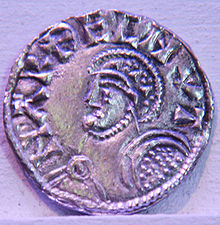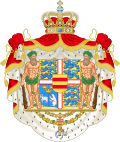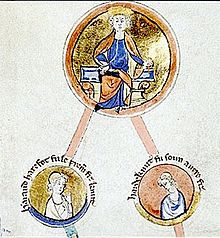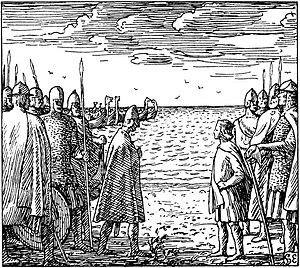- Harthacnut
-
For the legendary earlier king of Denmark, see Harthacnut I of Denmark.
Harthacnut King of Denmark and England 
Penny struck in Harthacnut's name King of Denmark Reign 1035 – 8 June 1042[1] Predecessor Cnut the Great Successor Magnus I King of England Reign 17 March 1040 – 8 June 1042 Coronation June 1040 (Canterbury) Predecessor Harold Harefoot Successor Edward the Confessor House House of Denmark Father Cnut the Great Mother Emma of Normandy Born c.1018
EnglandDied 8 June 1042 (aged 23–24)
Lambeth, EnglandBurial Winchester Cathedral, England Harthacnut[2] ("tough-knot";[3] Danish: Knud III Hardeknud) (c.1018 to 8 June 1042) was King of Denmark from 1035 to 1042 and King of England from 1040 to 1042.
He was the son of King Cnut the Great, who ruled Denmark, Norway, and England, and Emma of Normandy. When Cnut died in 1035, Harthacnut struggled to retain his father's possessions. Magnus I took of control of Norway, but Harthacnut succeeded as King of Denmark, and became King of England in 1040 after the death of his half-brother Harold Harefoot.
Harthacnut died suddenly in 1042, and was succeeded by Magnus in Denmark and Edward the Confessor in England. Harthacnut was the last Danish king to rule England.
Contents
Early life
Harthacnut was born shortly after his parents' marriage in July or August 1017.[3] Cnut had put aside his first wife Ælfgifu of Northampton in order to marry Emma, and according to the Enconium Emmae Reginae, a book she inspired many years later, Cnut agreed that any sons of their marriage should have precedence over the sons of his first marriage. In 1023 Emma and Harthacnut played a leading role in the translation of the body of the martyr St Æelfheah from London to Canterbury, an occasion seen by Harthacnut's biographer, Ian Howard, as recognition of his position as Cnut's heir in England.[4]
King of Denmark
In the 1020s Denmark was threatened by Norway and Sweden, and in 1026 Cnut decided to strengthen its defences by bringing over his eight year old son to be the future king under a council headed by his brother-in-law, Earl Ulf. However Ulf alienated Cnut by getting the Danish provinces to acknowledge Harthacnut as king without reference to Cnut's overall authority, and by failing to take vigorous measures to meet Norwegian and Swedish invasions, instead waiting for Cnut's assistance. In 1027 Cnut arrived with a fleet. He forgave Harthacnut his insubordination in view of his youth, but he had Ulf murdered. He drove the invaders out of Denmark and established his authority over Norway, and in 1028 he returned to England leaving Denmark to be ruled by King Harthacnut.[5]
Cnut had left Norway under the rule of Håkon Eiriksson, but he was drowned in 1029, and Cnut then appointed his son Svein to rule Norway with the assistance of Ælfgifu, Cnut's first wife and Svein's mother. However, they made themselves unpopular by heavy taxation and favouring Danish advisers over the Norwegian nobles, and when King Magnus I of Norway, the son of the former King of Norway, Olaf, invaded in 1035, they were forced to flee to Harthacnut's court. Harthacnut was a close ally of Svein, but he did not feel his resources were great enough to launch an invasion of Norway, and the half-brothers looked for help from their father, but instead they received news of his death in November 1035.[6]
England and Denmark
In 1035 Harthacnut succeeded his father on the throne of Denmark as Cnut III.[1] He was unable to come to England in view of the situation in Denmark, and it was agreed that Svein's full brother, Harold Harefoot, should act as regent, with Emma holding Wessex on Harthacnut's behalf. In 1037 Harold was generally accepted as king, Harthacnut being, in the words of the Anglo-Saxon Chronicle, "forsaken because he was too long in Denmark",[7] and Emma fled to Bruges, in Flanders. In 1039 Harthacnut sailed with ten ships to meet his mother in Bruges, but delayed an invasion as it was clear Harold was sick and would soon die, which he did in March 1040. Envoys soon crossed the channel to offer Harthacnut the throne.
While the general outline of events following Cnut's death are clear, the details are obscure, and historians give differing interpretations. M. K. Lawson in his DNB article on Harthacnut states that it is unclear whether Harthacnut was to have England as well as Denmark, but it was probably a reflection of a formal arrangement that mints south of the Thames produced silver pennies in his name, while those to the north were almost all Harold's. There might have been a division of the kingdom if Harthacnut had appeared straight away. He probably stayed in Denmark because of the threat from Magnus of Norway, but they eventually made a treaty by which if either died without an heir, his kingdom would go to the other, and this may have freed Harthacnut to pursue his claim to England.[3]
According to Ian Howard, Harthacnut agreed to help Svein recover Norway, and planned an invasion in 1036. Svein died shortly before it was to set out, but Harthacnut proceeded anyway. War was avoided by the treaty between Harthacnut and Magnus, which Harthacnut agreed to because he had no plausible candidate to rule Norway after Svein's death, and he was in any case temperamentally inclined to avoid campaigns and wars. Howard dates the treaty to 1036,[8] whereas other historians date it to 1039 and believe it freed Harthacnut to launch an invasion of England.[9][10]
In exile in Bruges Emma plotted to gain the English throne for her son. She sponsored the Enconium Emmae Reginae, a work which eulogised her and attacked Harold, especially for arranging the murder of her son by Æthelred, Alfred Atheling, in 1036. The work describes Harthacnut's horror at hearing of his brother's murder, and in Howard's view, was probably influential in finally persuading the cautious Harthacnut to invade England. According to a later edition of the Enconium, the English took the initiative in communicating with Harthacnut in 1039, possibly when it was known that Harold had not long to live.[11]
King of England
Harthacnut travelled to England with his mother. The landing at Sandwich on 17 June 1040, "seven days before Midsummer",[7] was a peaceful one, but he brought a fleet of 62 warships. Even though he had been invited to take the throne, he was taking no chances, and came as a conqueror with an invasion force.[12] The crews had to be rewarded for their service, and to pay them he levied a geld of more than 21,000 pounds, a huge sum of money which made him unpopular, although it was only a quarter of the amount his father had raised in similar circumstances in 1017-1018.[13]
Harthacnut had been horrified at Harold's murder of Alfred, and his mother demanded vengeance. With the approval of Harold's former councillors, his body was disinterred from its place of honour at Westminster and publicly beheaded. It was disposed of in a sewer, but then retrieved and thrown in the Thames, from which the London shipmen rescued it and had it buried in a churchyard.[14] Godwin, the powerful earl of Wessex, had been complicit in the crime as he had handed over Alfred to Harold, and Queen Emma charged him in a trial before Harthacnut and members of his council. The king allowed Godwin to escape punishment by bringing witnesses that he had acted on Harold's orders, but Godwin then gave Harthacnut a ship so richly decorated that it amounted to the wergild that Godwin would have had to pay if he had been found guilty.[15] Bishop Lyfing of Worcester was also charged with complicity in the crime and deprived of his see, but in 1041 he made his peace with Harthacnut and was restored to his position.[3]
The English had become used to the king ruling in council, with the advice of his chief men, but Harthacnut had ruled autocratically in Denmark and he was not willing to change, particularly as he did not fully trust the leading earls. At first he was successful in intimidating his subjects, though less so later in his short reign. He doubled the size of the English fleet from sixteen to thirty-two ships, partly so that he had a force capable of dealing with trouble elsewhere in his empire,[16] and to pay for it he severely increased the rate of taxation.[10] The increase coincided with a poor harvest, causing severe hardship. In 1041 two of his tax gatherers were so harsh in dealing with people in and around Worcester that they rioted and killed the tax gatherers. Harthacnut reacted by imposing a legal but very unpopular punishment known as 'harrying'. He ordered his earls to burn the town and kill the population. Very few people were killed as they knew what was coming and fled in all directions.[3][17]
The earl of Northumbria was Siward, but Earl Eadwulf of Bernicia ruled the northern part in semi-independence, a situation which did not please the autocratic Harthacnut. In 1041 Earl Eadwulf gave offence to the king for an unknown reason but then sought reconciliation. Harthacnut promised him safe conduct, but then colluded in his murder by Siward, who became earl of the whole of Northumbria. The crime was widely condemned, and the Anglo-Saxon Chronicle described it as "a betrayal" and the king as an "oath-breaker".[3][18]
Harthacnut was generous to the church. Very few contemporary documents survive, but a royal charter of his transferred land to Bishop Ælfwine of Winchester, and he made several grants to Ramsey Abbey. The twelfth-century Ramsey Chronicle speaks well of his generosity and his character.[3]
Harthacnut had suffered from bouts of illness even before he became King of England. He may have suffered from tuberculosis, and he probably knew that he had not got long to live.[19] In 1041 he invited his half-brother Edward the Confessor (his mother Emma's son by Æthelred the Unready) back from exile in Normandy and probably made him his heir. He may well have been influenced by Emma, who hoped to keep her power by ensuring that one of her sons was succeeded by another.[3] Harthacnut was unmarried and had no known children.
Death
On 8 June 1042, he died at a wedding in Lambeth, as he was drinking to the health of the bride[9] — he "died as he stood at his drink, and he suddenly fell to the earth with an awful convulsion; and those who were close by took hold of him, and he spoke no word afterwards…"[7] He was buried at Winchester, his father's place of rest,[9] and his mother's, on her death. Edward assumed the throne on Harthacnut's death, restoring the Saxon royal line of Wessex.
Reputation
Apart from the Ramsey Chronicle, medieval sources are hostile to Harthacnut. According to the Anglo-Saxon Chronicle he "did nothing worthy of a king as long as he ruled."[20] Modern historians are less dismissive. In the view of M. K. Lawson, he had at least two of the requisites of a successful medieval king, he was "both ruthless and feared"; had he not died young, the Norman Conquest might not have happened. Ian Howard praises Harthacnut for keeping peace throughout his empire, benefiting trade and merchants, and ensuring a peaceful succession by inviting Edward to his court as his heir. Had he lived longer, Howard believes, his character might have enabled him to become a successful king like his father.[21]
Ancestry
Ancestors of Harthacnut 16. Gorm the Old 8. Harald I of Denmark 17. Thyra 4. Sweyn Forkbeard 18. (trad.) Olof II Björnsson 9. (trad.) Gyrid Olafsdottir 2. Cnut the Great 5. (legendary) Sigrid the Haughty 1. Harthacnut 24. Rollo 12. William I, Duke of Normandy 25. Poppa of Bayeux 6. Richard I, Duke of Normandy 13. Sprota 3. Emma of Normandy 7. Gunnora, Duchess of Normandy References
- ^ a b Monarkiet i Danmark - Kongerækken at The Danish Monarchy
- ^ Sometimes referred to as Harthacanute, Hardicanute, Hardecanute, or Hörthaknútr.
- ^ a b c d e f g h M. K. Lawson, Harthacnut, Oxford Online DNB, 2004
- ^ Ian Howard, Harthacnut: The Last Danish King of England, The History Press, 2008, pp. 15, 27
- ^ Howard, op. cit., pp. 29-38.
- ^ Howard, op. cit., pp. 42-51
- ^ a b c The Anglo-Saxon Chronicle
- ^ Howard, op. cit., pp. 58-61
- ^ a b c Carl Frederik Bricka, Dansk Biografisk Lexikon, vol. VII, I. Hansen - Holmsted, 1893, pp.91-92.
- ^ a b Knud 3. Hardeknud at Gyldendals Åbne Encyklopædi
- ^ Howard, op. cit., 105-107
- ^ Howard, op. cit., p. 109
- ^ Howard, op. cit., p. 117
- ^ Howard, op. cit., pp. 111-112
- ^ Howard, op. cit., pp. 112-117
- ^ Howard, op. cit., pp. 118-119
- ^ Howard, op. cit., pp. 119-120
- ^ Howard, op. cit., pp. 120-121
- ^ Howard, op. cit., pp. 106, 124, 149
- ^ Howard, op. cit., p. 119
- ^ Howard, op. cit., p. 136
External links
 "Hardecanute". Encyclopedia Americana. 1920.
"Hardecanute". Encyclopedia Americana. 1920.
Regnal titles Preceded by
Cnut the GreatKing of Denmark
1035–1042Succeeded by
Magnus the GoodPreceded by
Harold HarefootKing of the English
1040–1042Succeeded by
Edward the ConfessorMonarchs of Denmark Early monarchs c.916–1412(Harthacnut) · Gorm the Old · Harald Bluetooth · Sweyn Forkbeard1 · Harald II · Cnut the Great1 · Harthacanute1 · Magnus the Good · Sweyn II · Harald III · Canute the Saint · Olaf I · Eric Evergood · Niels · Eric the Memorable · Eric Lamb · Sweyn Grathe / Canute V / Valdemar the Great · Canute VI · Valdemar the Victorious / Valdemar the Young · Eric Plough-tax · Abel · Christopher I · Eric Klipping · Eric Menved · Christopher II · Valdemar III · Christopher II · Interregnum · Valdemar Atterdag · Olaf II · Margaret I2
Palatinate-Neumarkt 1397–1448Oldenburg 1448–1863Christian I2 · John2 · Christian II2 · Frederick I · Christian III · Frederick II · Christian IV · Frederick III · Christian V · Frederick IV · Christian VI · Frederick V · Christian VII · Frederick VI · Christian VIII · Frederick VIISchleswig-Holstein-
Sonderburg-Glücksburgsince 1863English monarchs Kingdom of the
English
886–1066- Alfred the Great
- Edward the Elder
- Ælfweard
- Athelstan the Glorious1
- Edmund the Magnificent1
- Eadred1
- Eadwig the Fair1
- Edgar the Peaceable1
- Edward the Martyr
- Æthelred the Unready
- Sweyn Forkbeard
- Edmund Ironside
- Cnut1
- Harold Harefoot
- Harthacnut
- Edward the Confessor
- Harold Godwinson
- Edgar the Ætheling
Kingdom of
England
1066–1649- William I
- William II
- Henry I
- Stephen
- Matilda
- Henry II2
- Henry the Young King
- Richard I
- John2
- Henry III2
- Edward I2
- Edward II2
- Edward III2
- Richard II2
- Henry IV2
- Henry V2
- Henry VI2
- Edward IV2
- Edward V2
- Richard III2
- Henry VII2
- Henry VIII2
- Edward VI2
- Jane2
- Mary I2 with Philip2
- Elizabeth I2
- James I3
- Charles I3
Commonwealth of
England, Scotland and Ireland
1653–1659Kingdom of
England
1660–1707- Charles II3
- James II3
- William III and Mary II3
- Anne3
1Overlord of Britain. 2Also ruler of Ireland. 3Also ruler of Scotland. 4Lord Protector.
Debatable or disputed rulers are in italics.Categories:- Danish monarchs
- English monarchs
- Viking Age monarchs
- Anglo-Norse monarchs
- Roman Catholic monarchs
- 1018 births
- 1042 deaths
- Burials at Winchester Cathedral
Wikimedia Foundation. 2010.


